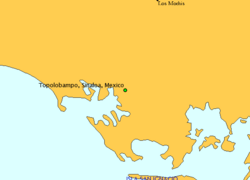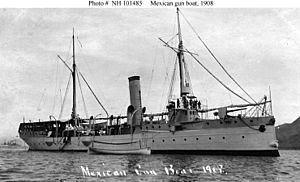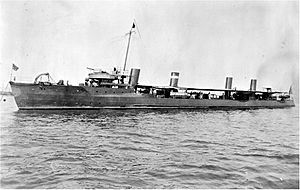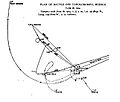Fourth Battle of Topolobampo facts for kids
Quick facts for kids Fourth Battle of Topolobampo |
|||||||
|---|---|---|---|---|---|---|---|
| Part of the Mexican Revolution | |||||||
 Map of the Fourth Battle of Topolobampo, drawn by the U.S. Navy observers during the battle. |
|||||||
|
|||||||
| Belligerents | |||||||
| Commanders and leaders | |||||||
| Captain Hilario Malpica† | Captain Navio Torres | ||||||
| Strength | |||||||
| 1 gunboat | 1 gunboat | ||||||
| Casualties and losses | |||||||
| 7 killed, ~30 wounded, unknown captured, 1 gunboat sunk |
unknown wounded, 1 gunboat damaged |
||||||
|
|||||||
The Fourth Battle of Topolobampo was a naval battle during the Mexican Revolution. It was the last fight in the Topolobampo Campaign, a series of naval clashes. In June 1914, a gunboat from the Huertistas (who supported the government) sank a gunboat from the Constitutionalists (the rebels). This happened near Topolobampo, Sinaloa, a port city in Mexico, in the Gulf of California.
Contents
A Shipwrecked Start: The Background of the Battle
After an earlier battle, the Constitutionalist gunboat Tampico had sunk. But rebel sailors, led by Captain Hilario Malpica, managed to raise their ship. It had been partly underwater near Shell Point, at the entrance to Topolobampo Bay.
American Observers
Several United States Navy ships were in the area. They were there to watch the fighting. These ships included the Flagship USS California, USS New Orleans, USS Preble, and USS Perry. They were all part of the United States Pacific Fleet, led by Rear Admiral Thomas B. Howard on the California. Another ship, USS Yorktown, was also nearby. Much of what we know about these battles comes from the reports written by Admiral Howard and his officers.
Tampico is Found
On June 11, 1914, Admiral Howard spotted Tampico near Mazatlán. On June 14, he heard that Tampico was sailing away from Topolobampo towards Altata. He ordered the destroyer USS Preble, commanded by Lieutenant Junior Grade Vance Duncan Chapline, to find and follow Tampico.
Preble quickly set off. The destroyer Perry, which was near La Paz, was also told to go to Topolobampo. Preble didn't know where Tampico was going or how fast, so it sailed slowly, hoping to find the ship by morning.
Around 7:30 am on June 15, Tampico was spotted. Preble got within two miles of Tampico and stopped. Tampico's crew saw Preble and also stopped. A Mexican officer from Tampico boarded Preble. He explained that Tampico had been underwater for two months after the last battle.
Tampico's Mission and Problems
On June 14, Tampico had left Topolobampo with only one working boiler. Captain Malpica wanted to sail to Altata, Mexico. There, he hoped to fix Tampico's boilers and other machinery.
Malpica's plan was to then attack the Huertista gunboat Guerrero, which was based in Guaymas. After sinking Guerrero, Tampico would attack other ships along Mexico's west coast.
However, Tampico had only sailed about thirty miles when its last working boiler broke down. This left the Constitutionalist sailors stuck without power. They tried to fix the boiler, but couldn't. Captain Malpica asked the American destroyer to tow Tampico to Altata, which was eighty miles away. By this time, USS Perry had arrived. Lieutenant Chapline had to say no to Malpica's request. Towing the ship would have broken America's rule of staying neutral (not helping either side). The Mexicans then asked Chapline to send a radio message to Rear Admiral Howard. Captain Malpica also asked Chapline to visit him. Preble's radio operator sent the message.
A Visit to Tampico
Around 5:30 pm, Chapline went aboard Tampico. Captain Malpica had an injury to his foot and could barely walk. He was happy that a message had been sent to Admiral Howard. He invited the Americans to look at Tampico's poor condition.
The U.S. Navy officers inspected the Mexican gunboat. It had two 4-inch guns, two 6-pounder guns, and one machine gun on the bridge. The 4-inch guns were in bad shape. Their parts were loose, the inside of the barrels were worn out, and the aiming gears were dirty. The rear gun sights also didn't line up with the front sights.
The two 6-pounder guns seemed fine. Tampico had about 100 to 200 4-inch shells. But most of them were damaged from being outside or from being underwater in Topolobampo Bay. The 6-pounders had plenty of ammunition, but these shells were also in bad condition and dangerous to fire. Boxes of small arms ammunition were everywhere on the ship. Some were full, others were broken. Three cows were even roaming around in the ship's hold!
The ship's engines were rusty and in bad shape. The generator was ruined by salt water, so there were no lights. The crew had to use lanterns at night. Both boilers were "dead." Their front covers and other parts were missing. Salt crystals hung from the tubes inside the boilers. About 500 tubes needed to be plugged. The rebels had used wooden table legs to plug the holes!
Many of Tampico's crew members had bandages from earlier fights. Besides Captain Malpica, the crew included an executive officer, a chief engineer, an assistant engineer, and three machinists. There were twenty-nine sailors and twenty-five rebel soldiers, making a total of sixty-one men. The American captain told Malpica that a reply from Howard probably wouldn't come that day. The U.S. sailors went back to their ship. Tampico would be sunk before the Americans received a reply.
Guerrero Approaches
The Huertista ship Guerrero had six 4-inch guns and was commanded by Captain Navio Torres of the Mexican Navy. When the American commander asked Malpica what he would do if he met Guerrero, Malpica said, "I'll fight her and sink her if she will only come within range of my guns."
At 8:00 pm that night, Chapline heard a radio message from USS New Orleans, commanded by Commander Noble E. Irwin. The message said that New Orleans was following Guerrero as it sailed south from Guaymas, heading straight for Tampico. With this information, the Americans guessed that Guerrero and New Orleans would arrive around 7:00 am the next morning.
Tampico was in terrible shape for its last battle. Also, sometime during the night of June 15, it drifted onto a shoal (a shallow area) and got stuck. This was the spot where Guerrero would sink Tampico for the last time. The commanders of Perry and Preble were ordered to simply wait for Guerrero and New Orleans. They were told to report everything that happened in the battle, but not to help either side. This meant the Americans could not warn Tampico about Guerrero coming, as it would break their neutrality.
The Battle Begins
Just before daylight on June 16, 1914, the two American destroyers and Tampico saw two fast-approaching ships to the north. The weather was clear and warm, with a slight breeze. The California Gulf was very calm. Around 5:30 am, the two ships were identified as Guerrero and USS New Orleans. Guerrero stopped and got ready for battle. Around 7:00 am, it began to move towards Tampico.
Tampico raised its Mexican National Ensign (flag), and its lifeboats were lowered on the side not facing the enemy. These were the only preparations the rebels made. The Huertista gunboat also raised its flag, which was the same as Tampico's but smaller. Tampico started the fight at 7:47 am by firing its 4-inch guns at the now stopped Guerrero.
First Shots and American Reactions
Tampico's shots fell short. Guerrero fired back with one gun, and its shots landed far past Tampico. A gun battle from about 8,000 yards (7,300 meters) continued for a while. The crews of the American ships were very excited, according to Lieutenant Chapline. They mostly supported Tampico, not because of politics, but because they knew how bad Tampicos condition was. The Americans stood on their decks and climbed up the ship's rigging to watch with binoculars. Whenever one of Tampicos shells landed near Guerrero, the Americans cheered. When Tampico was hit, they groaned and criticized the poor shooting of both ships. The battle went on for about an hour before either side scored a hit.
During the fight, Preble sailed back and forth between the two Mexican gunboats. Whenever Guerrero turned, the Americans followed its movements. But they never got closer than one or two miles away. Eventually, most of Tampicos guns were firing: its two 4-inch guns and the 6-pounder on the right side. The machine gun on the bridge and the 6-pounder on the left side were never used. Guerrero never came close enough for small arms fire and always stayed on Tampicos right side. It used all of its 4-inch guns. Lieutenant Chapline had a yeoman (a naval clerk) stand near him with a stopwatch, pad, and pencil. The yeoman's job was to write down every event and the time it happened. The shooting from both Mexican gunboats was described as very "erratic" (unpredictable). Later, while watching Tampico, the crew of Preble saw that the Constitutionalist gunners would aim, then lie down and pull the firing rope, without trying to aim properly.
The crew of Preble thought Guerrero's gunners did the same. But Lieutenant Chapline disagreed, saying he could see Guerreros gun pointers just before it fired. At 7:51 am, the distance between the ships got a little smaller. So Guerrero changed course to the right and away from Tampico. At 8:02 am, Guerrero stopped for a moment, aiming its right side guns at Tampico and fired. The distance was about 6,000 yards (5,500 meters). Still, neither Mexican gunboat hit the other. Many of Tampicos shells fell about 3,000 yards (2,700 meters) in front of Guerrero. The Americans thought this was because of water-damaged ammunition or the dirty aiming gears on the 4-inch guns.
Hits and Damage
At 8:20 am, Guerrero turned again, showing its left side guns to Tampico before firing more shots. The Americans reported that the firing got faster, but all shells were still falling short. At 8:22 am, Guerrero slowly started moving towards Tampico. At 8:24 am, after more than half an hour of fighting, it made its first hit. The shell hit the main deck between the poop deck and the main mast. A big cloud of white smoke showed the hit, but Tampico didn't seem to be badly damaged. This was a shrapnel shell. After the battle, the Americans learned that Guerrero mostly fired shrapnel rounds.
The rate of fire slowed down a bit, and no more hits were made for a few moments. At 8:34 am, one of the lifeboats attached to Tampico's right side broke loose and drifted away. A minute later, Guerrero moved to within 4,000 yards (3,700 meters) and then turned left, away from Tampico. This was the closest the two warships got to each other. It is believed that at this distance, Tampico hit Guerrero twice. However, these hits did not cause major damage.
Guerrero turned again at 8:40 am. A few minutes later, it scored its second hit. This shell hit Tampico's gaff, which pulled down the large Mexican flag. Again, there was no major damage to the ship, but the crew's spirits were hurt. Two minutes later, at 8:50 am, Guerrero turned away from Tampico, then came back around and showed its left side guns from 5,000 yards (4,600 meters). Guerrero fired, and from this point on, several more rounds hit Tampico. The Americans noticed that Guerrero was firing two shots per minute with its four guns, while Tampico fired one shot every two minutes with three of its guns.
Since Tampico only had 100 to 200 4-inch shells at the start, the Americans thought Captain Malpica might have been saving his armor-piercing shells for when Guerrero got closer. Two more lifeboats drifted away at 9:01 am. A few minutes later, Guerrero began to fire salvos (many guns firing at once). One salvo hit the water 500 yards (460 meters) past Tampico, another 1,000 yards (910 meters) past, and a final one 2,000 yards (1,800 meters) past. None of these shots hit.
Guerrero was still heading for Tampico at 9:14 am when it slowed down and fired more shots before turning left again at 9:17 am. Lieutenant Chapline later found out that Tampico was hit more often than he and his crew saw. One hit the front right side, near the unused 6-pounder gun, and exploded inside the forecastle (the front part of the ship). Another hit near the left 4-inch gun, which seemed to damage it, as it wasn't fired again after about 9:10 am. At 9:18 am, a shrapnel shell exploded just in front of Tampico. This shell didn't seem to harm Malpica's gunboat, but the metal pieces killed some crew members standing on deck.
Tampico Sinks
A few minutes later, smoke and fire were seen on Tampico's back deck. No one tried to put out the flames. Tampicos boilers were broken, so there was no water pressure to fight the fire. At 9:42 am, Captain Malpica ordered his crew to leave the ship. At 9:45 am, the flames on Tampicos back deck grew larger, and a lot of smoke covered Tampico.
Men aboard the rebel gunboat kept firing the remaining 4-inch gun as others left their ship. One of the gunners took the large Mexican flag and held it up by hand until all the other crew members were safely in lifeboats. Guerrero kept shooting until 9:50 am when the battle ended.
Tampico's crew, in their boats, started heading for shore. So Guerrero sped towards the lifeboats to capture the rebels before they could reach shallow water and escape. Preble went to Tampico to help any crew members who remained on board.
Preble got within 50 yards (46 meters) of Tampico. There, its crew saw several Mexicans running around on deck, waving white rags as a sign of surrender. The men climbed down the anchor cable but refused to jump into the water to swim to the American destroyer. During all this, the fire was spreading on Tampico and started setting off the boxes of small arms ammunition. A moment later, the fire reached the powder magazine. A large explosion happened, and 4-inch shells were launched in "every direction," according to Lieutenant Chapline. Some of the shots passed through Preble's rigging. USS New Orleans lowered two boats and sent them to pick up the rest of Tampicos crew, six men. The last man rescued was Tampicos paymaster, Rebatet, who was found by Guerrero, badly wounded and holding onto a piece of wooden wreckage.
Aftermath of the Battle
After about thirty minutes of chasing, Guerrero caught up with the two boats carrying Tampicos crew. There was no way to escape, so Captain Malpica ordered his boats to go alongside Guerrero to surrender. As the rebel sailors were climbing up Guerreros ladder, Captain Hilario Malpica stood up in his boat. He took his revolver, calmly put it to his head, and fired.
Immediately, Captain Torres of Guerrero ordered his flag to be lowered halfway to honor Captain Malpica, who had died. The American ships did the same. After the fighting was over, Lieutenant Chapline learned from Captain Torres that Malpica was a well-respected man, even though he had led a mutiny (rebellion) months earlier. Malpica had served with many of Guerrero's crew members before his mutiny. Captain Torres sent a radio message to Commander Irwin of New Orleans, thanking the United States Navy warships for honoring Malpica.
After taking some prisoners, Guerrero returned to a spot 400 yards (370 meters) south of the burning Tampico. Guerrero dropped anchor, and boats were sent to Tampico to check its condition.
A tow-line was passed from the back of Guerrero to Tampico's front. But Tampico was too damaged to be saved, so the tow-line was later cut. Tampico finished sinking to the bottom. By 12:00 am, Tampico was fully submerged under 22 fathoms (about 132 feet or 40 meters) of water.
A U.S. Navy medic helped treat some wounded crewmen aboard Guerrero. The Americans also saw two shot-holes when they went aboard Guerrero. Captain Torres told Lieutenant Chapline that he had ordered his crew to aim high. He hoped to kill Tampico's crew without damaging the gunboat.
Tampico was hit a total of twelve times during the fight. Five shells hit above the waterline, and seven hit underneath. Five men were killed during the battle, not counting Captain Malpica. Another man died the next day. Around thirty rebel sailors were wounded, with twelve of them seriously hurt. Captain Torres did not ask New Orleans to hand over the six men it had picked up. They were later taken to the United States and avoided becoming prisoners of war.
Images for kids






